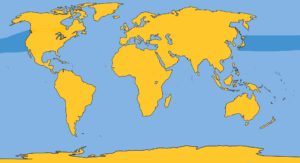Family: Ziphiidae
Genus: Mesoplodon
Species: M. carlhubbsi Moore, 1963
Described in 1963 by J.C. Moore, this animal is known from about 30 strandings, the first discovered in 1944. Some researchers believe that Hubb’s beaked whale, Stejneger’s beaked whale, and Andrew’s beaked whale are merely geographic variations of the same animal, for they are similar in many ways. The paucity of specimens is in part to blame for the taxonomic controversy.
Physical Description: Stocky body. The lower jaw extends slightly ahead of the upper jaw. The throat displays the typical wishbone indentation.
Color: All black except for white rostrum and white forehead. Some light spots cover the body. Males are often covered with tooth rakes from males, probably during mating competition.
Fins and Flukes: The small falcate dorsal fin is located at the extreme rear of the mid-back region. Thin flippers appear disproportionately small compared with the body. Well-developed flukes are pointed at the tips, with no median notch.
Length and Weight: These animals reach at least 17 ft. (5.2 m).
Teeth: A pair of teeth, flattened and rounded at tips, is located on the sides of the lower jaw in males. These teeth are about 3.5 in. (9 cm) long, 6.25 to 6.5 in. (16 to 16.5 cm) deep, and .25 in. (.65 cm) broad, and have a straight leading edge that faces forward and are frequently found to be worn down.
Feeding: Squid and mesopelagic fish.
Breathing and Diving: No information available.
Mating and Breeding: Calving season is estimated to be in midsummer.
Herding: Groups of up to 10 are likely.
Distribution: Temperate waters of the North Pacific from Japan east to British Columbia and California.
Migration: No information available.
HUBB’S BEAKED WHALE DISTRIBUTION










